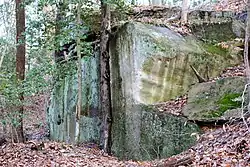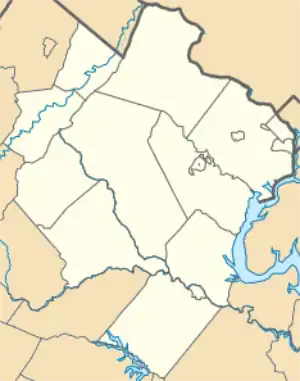Public Quarry at Government Island
The Public Quarry at Government Island in Stafford County, Virginia is the principal source of Aquia Creek sandstone, a building stone used in many of the early government buildings in Washington, D.C., including the U.S. Capitol and the White House. A quarry was established just off the Potomac River at Wigginton's Island on Aquia Creek by George Brent after 1694, providing stone for tombstones and to houses and churches in northern Virginia, including Gunston Hall, Christ Church in Alexandria, Virginia, Mount Airy in Richmond County, Virginia, and Aquia Church, as well as steps and walkways at George Washington's Mount Vernon.[3] Washington selected Aquia sandstone as the primary material for use in Washington's government buildings. Acting on the government's behalf, the Wigginton's Island quarry was purchased by Pierre Charles L'Enfant in 1791, becoming known afterward as Government Island.[3]
Public Quarry at Government Island | |
 | |
   | |
| Location | Stafford County, Virginia |
|---|---|
| Nearest city | Stafford, Virginia |
| Coordinates | 38°26′54″N 77°23′0″W |
| Area | 17.4 acres (7.0 ha) |
| Built | 1791 |
| NRHP reference No. | 03000457[1] |
| VLR No. | 089-0103 |
| Significant dates | |
| Added to NRHP | May 30, 2007 |
| Designated VLR | March 19, 2003[2] |
Use of the stone declined as its susceptibility to weathering was observed, and the quarry became worked out and derelict after the U.S. Civil War. The property was sold by the U.S. Government in 1963.[3]
The property was acquired by Stafford County as a county park and opened to the public on November 6, 2010 with trails and markers highlighting the historical significance of the island. The park has 1.5 miles of trails including an elevated wooden boardwalk through marsh and wetlands, part of the park is handicap accessible. It is a designated site on the Potomac Heritage National Scenic Trail.[4] It was listed on the National Register of Historic Places in 2007.[1]
References
- "National Register Information System". National Register of Historic Places. National Park Service. July 9, 2010.
- "Virginia Landmarks Register". Virginia Department of Historic Resources. Retrieved 5 June 2013.
- "Statement of Durand Jones, Deputy Director, National Park Service, Department of the Interior, before the Subcommittee on National Parks, Recreation and Public Lands of the House Committee on Resources, regarding H. RES. 261, recognizing the historic significance of the Aquia Sandstone quarries of Government Island in Stafford County, Virginia, for their contributions to the construction of the Capital of the United States". U.S. Department of the Interior. Retrieved 2 February 2015.
- "Government Island". Stafford County Economic Development Authority. Retrieved 6 November 2010.

